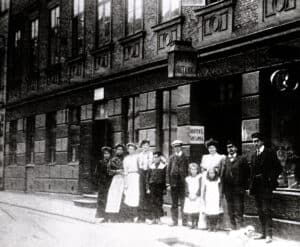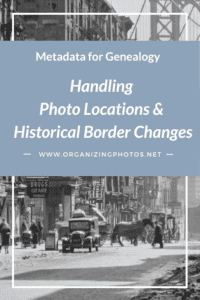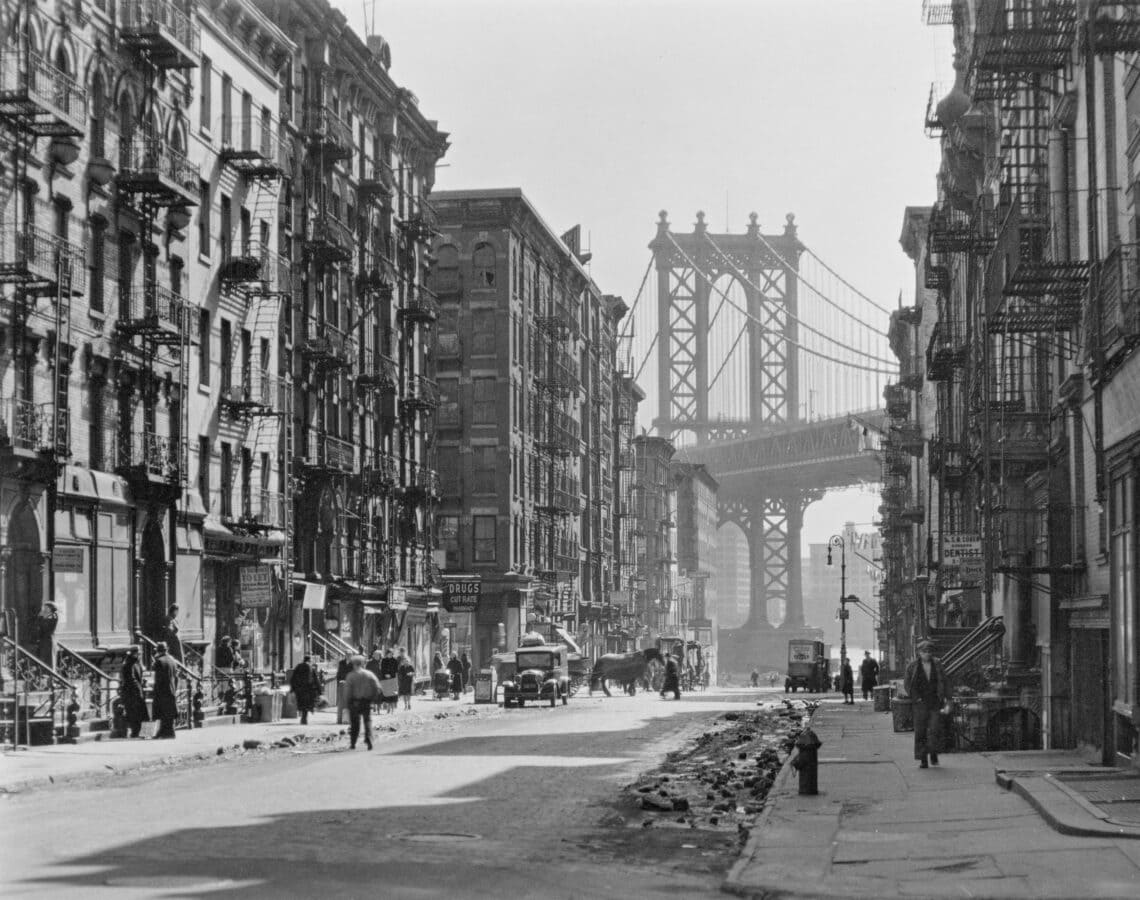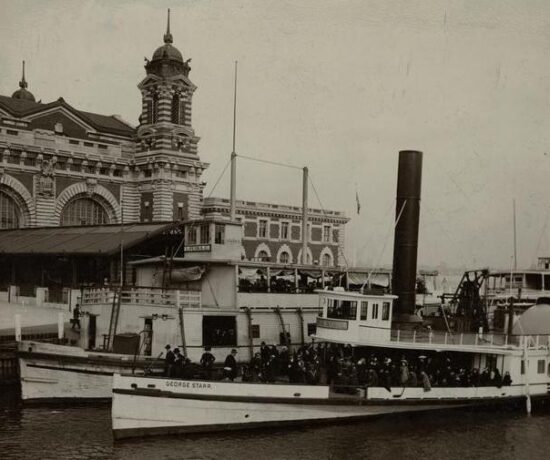In our last post, we talked about the most important IPTC metadata fields to use in your family archive, and today, I want to go deeper into photo locations. How do we distinguish between where something was taken, vs. what is depicted, and how do we handle historical border changes in our archives? What if we’re dealing with a completely different country now than what it was when the photo was taken? Let’s dive into this culturally fascinating topic. Oh, and if you missed part 1, 2, and 3 in this series, be sure to read those too! Enjoy!
Why Photo Locations are Important to Break Down
We naturally think of a photograph as a specific point in time, but in my opinion, the context of where it was taken is equally interesting. Without knowing the location where a photo was taken, and its subsequent cultural context, it’s hard to grasp the full impact of the image. Yes, we can gather a lot by looking at what’s depicted in the photo, but understanding its exact whereabouts adds another dimension of conversation.
To illustrate my point, let’s say that I have a photo of a family member standing on a busy street in Gothenburg in 1901. Without knowing the exact name and location of that street, I can only speculate as to what they were doing there. However, if I know that the name of that street is Postgatan, and that it’s located right by the Packhuskajen, the dock where most Swedish emigrants left for America, the context all of a sudden becomes a lot more clear. The time in which a photo was taken is a big part of it, sure, but so is the location. Don’t forget this important piece of the puzzle because it reveals so much of the story.

Carl E. Bengtsson and staff at Hotel Britannia, Postgatan, Gothenburg, Sweden, ca 1900. Photo courtesy of Wikimedia Commons.
But First, Semantics.
Before you get into actually filling out photo locations in your photo metadata, it’s important that you are clear on exactly what you’re filling out and why, and that is part of planning out your metadata strategy. In order for you to avoid the ever-so-common metadata “do-over,” and for future generations to understand the context of your photos, we need to know what is meant by the words “place,” “location,” “sub-location,” and so on.
What is the location? What is the place? Sometimes in everyday life, we talk about these things interchangeably. In your documentation, however, you have an opportunity to spell out exactly what you mean by those words. You may think that they are obvious, but believe me, it’s not that simple – especially not if your definitions differ from the official dictionary. For the sake of consistency, be clear on exactly what you mean from the get-go.
What Does the Photo Management Program Say?
Besides being clear on what YOU mean by this, also be clear on what your photo management program means by this. It’s not uncommon for us to see some programs called something a “location,” but mean “place,” and vice versa. This happens with other fields as well (Headline vs. Title, anyone?), and it’s why we need to have an upfront strategy. I recommend that you look to see what type of language your program uses, and compare that to how you want to talk about things – just so that you’re clear on all the different fields and options that you have available to you.

I’m a Perfect Pinnable!
How I Choose To Define Photo Locations
I’ve given a great deal of thought to how I want to approach photo locations (and to my teaching methods around the topic), so below is a quick summary of how I approach my metadata strategy. Feel fee to use the same definitions if you like them.
Place
It was very important for me to be able to specify exact physical locations as well as to include more generic keywords, such as “airport,” “monument,” and so on, in my family photo archive. I’ve chosen the word “place” to classify generic keywords that add context to the location fields. In other words, “place” is the root of a collection of keywords in my controlled keyword vocabulary.
Sometimes, just hearing the name of something isn’t enough to understand what it is. For example, let’s say that I visit a store called “Anderson’s Best” in Geneva, Illinois. Do they sell clothing? Tiling supplies? Baked goods? Exactly. Someone who has never been there wouldn’t know – unless we provide more context around the name in the photo metadata. Without going into a side-note on branding, let’s just conclude that it’s helpful to have additional information in those types of scenarios where it’s not immediately obvious what something is (or should be).
Location
I reserve the word “location“ for the actual name, so that’s the field in which I would enter “Anderson’s Best.” We have to put that name somewhere, and in my opinion, it’s not enough to include that in the caption. The caption field is clearly another great field to use in order to elaborate on the story, but the two fields are not mutually exclusive.
City
This field is easy to understand, but sometimes, we have to think about what exactly constitutes a city. If your hometown (like mine) is fairly small, do we go by the official definition of a city, which is “a human settlement of a notable size” (according to Wikipedia). What is a notable size? And if the city in question is more of a village, do we use the name of the village instead? Again, some of this may seem obvious to you now, but these are the types of questions your metadata strategy needs to answer, so that consistency reigns. In my documentation, the city is defined as the name of the city or village where the photo was taken, even if it’s not of “notable size.”
State / Province
In many countries, there are clear state boundaries which define both clerical and administrative governance, but not so in all countries. Take Sweden, for example, which is divided up into 25 provinces from north to south. These provinces are largely traditional today, meaning they serve no administrative functions, but historically that hasn’t always been the case. Are these traditional provinces what you will enter into your metadata, or will you also include counties, if known? The reason I ask is because you have to be crystal clear on the answer in order to avoid problems down the road.
Västergötland is a great example. This western province is large and fairly well-known in the genealogy world since many emigrants originated there, so it might be a name that pops up in your photo archive if you’re of Swedish descent. Västergötland is often confused with Västra Götaland, which is one of the counties in that province. That county is what serves the administrative function and what is often what is referenced in genealogical materials. The borders of the two don’t exactly match up, so they aren’t the same thing and shouldn’t be named interchangeably. Therefore, it’s important to define whether you will include “counties” in your photo locations metadata, and how you will differentiate between that, compared to a state or province.
Since there is no separate field for “county,” DIYers often add whatever information they have available in this metadata field, but the result is then inconsistency. You get a mishmash of states, counties, and provinces that aren’t consistently entered. Then, any time you want to go deeper into research on a particular photo, you will find yourself looking for a county named “Västergötland” where none exists. In genealogical work, that type of inconsistency is a slippery slope.
Country / Region
Some photo programs treat “Country” and “World Region” as the same thing, but are they? No, not necessarily. This is another issue that can pop up during work with historical and genealogical collections. Do you convey the country in which the photo was taken at the time? … or the country that location belongs to now? This is up to you to define.
Let’s consider a fun scenario for this. Pretending that I am an archeologist out at a dig site, let’s say that I discover a beautiful vase from the Mesopotamian era and I take a photo of it. What will be included in the metadata of that photo? The country I’m currently standing in? Well, it depends, and that’s why you have to define your metadata strategy.
In a scenario like this, you could think of it in several ways. If you wanted to portray ancient Mesopotamia as modern-day Iraq, that might be the most accurate entry for “country,” assuming that the dig site is there. However, if I think about Mesopotamia in the broader historical context of “world region,” it would be somewhat inaccurate to name Iraq specifically, since Mesopotamia also included parts of Kuwait, Syria, Iran, and Turkey. The current culture is not necessarily an accurate reflection of the historical culture.
Since that was a pretty far-fetched scenario, let’s consider another one closer to modern times. What if you have a series of photos of family members taken in Prague between the years of 1900-1999? What country and/or world region would you apply to those photos? Austria-Hungary? Bohemia? Czechoslovakia? The Czech Republic? Naturally, you would keep the time period of each photo in mind, but without defining a clear metadata strategy, the answer might not be so simple.
ISO Country Code
Thank goodness for the ISO country code. It’s the one field that is very clear from the beginning, so at least there’s one where we don’t have to put in so much brain power. Some people get confused by “country code” and think of it as the phone number code, but that’s not quite right. ISO stands for the International Standards Organization, which is a body that develops and publishes standards for international use. They have a list of country codes that are used in metadata work, and that’s what you’ll want to reference in this field. This field really depends on the country field, and simply tags along as a supporting piece of information.
Location Shown vs. Location Taken
Besides the core fields for our photo locations, I also like to use some of the extension fields, more specifically “Location Shown” and “Location Taken.” I like these fields because they clear up confusion, and help the observer understand exactly what is depicted in a particular photo.
Consider this scenario: I’m currently standing at the Terrapin Point Observation Tower in New York state, but I’m taking a picture of the gorgeous waterfall across the border. What do I put in my metadata? The location where the photo was actually taken (in this case, Niagara Falls, New York, United States), or what the photo actually depicts (in this case, Horseshoe Falls, Ontario, Canada)? This is where these extension fields come in handy. Your metadata strategy should clearly define if you use these fields or not, and if you don’t, what does the metadata used actually represent?
A-I-N or A-W-T: Dealing with Historical Border Changes
As you already know, either from doing genealogy research or from reading this article, a very common consistency issue that we come across in genealogy is historical border changes.
How do you treat historical border changes in metadata? Do you put what it was then? … or do you put what it is now? That’s what refer to as the AIN-AWT problem (As-Is-Now vs. As-Was-Then). Which one do you pick and why?
I’ve come across this many times in my personal archive, as will you. My hometown Ystad is a perfect example. It’s located on the southern tip of Sweden, and before 1658, it was Danish (going back hundreds and hundreds of years). However, it now belongs to Sweden. How do I keep my archive historically accurate without having a big mess on my hands?
Before you email me in confusion, asking what photos I have that are dated pre-1658, let me clarify that I include photos of genealogical records as well as actual documents in my collection too. I prefer to keep one collection that includes all my family history. As a resylt, it spans well over a thousand years and includes multiple types of files, not just photos.
Scandinavia is one of those areas that is very lucky in terms of resources. We have a lot of records; they are well preserved, and they are well organized. I have hundreds of photos of genealogical documents from the middle ages, for example, and I date them as I would photos, by logging them chronologically. How do I keep track of the creation date of the original document vs. the creation date of the photo itself? Ah, yes. Good question, but more on that in another post, or this will never end.
Opt for Historical Accuracy
I could talk for hours about this, but I’ll cut to the chase now, and tell you what I do.
I always opt for historical accuracy, and here’s why:
As I mentioned up top, a photo is naturally a point in time, and I want to communicate what the culture was like at that point in time. Just like with maiden names, history is not going to change. The future might. In many cases, a monument, store, or other specific location may not exist in today’s world. That’s why I feel like it’s always better to go with what was accurate at the time, i.e. AWT. I think those specific moments in history deserve to be treated as such. The bigger benefit to you is that you don’t have to update the metadata in the event of changes.
To summarize, I use headlines, captions, and all of the location fields to tell the story of the photo and to hold all of the historical information, but I use keywords (including name synonyms) and maps in order to be able to find what I’m looking for, and to convey modern context. It’s an advanced strategy, but I believe it to be the best option out there.
The Takeaway? Photo Locations Need to Be Defined.
Your assignment is to create a solid metadata strategy, and to clearly define what fields you use, why, and what type of information gets entered into those fields. Communicating your chosen methods are what prevents the do-overs and lets others understand the thought process behind the information. Photo locations can be a bit tricky because of semantics, but as long as you are clear on what you mean and why, consistency isn’t out of reach. In fact, quite the opposite. It’s inevitable.
My recommendation is that you preserve as much historical and cultural context as possible because that is what tells the story.
Want to Learn How to Strategize Better?
If you’re interested in learning more about creating your own metadata strategy, including how to treat photo locations, consider enrolling in our Metadata for Genealogy Workshop. We held it last year during family history month, and the replay is available for anyone who may have missed it. See the preview below.
This is by far our most popular workshop, and in it, you’ll learn exactly what IPTC metadata fields to use, and what to consider when putting together your own family archive metadata strategy (simple template included). Naturally, all of my recommendations are in there too, so you have references and a place to start.
For more in-depth help that starts from the absolute beginning, consider joining us in our full course DPO PRO: The Ultimate Photo Organizing Masterclass. That’s where we strategize together, and help you through each step of the photo organizing process. We also have private coaching sessions available for anyone who’d like to fool-proof their procedures.
In a nutshell, if you’re gonna do it, spend your time doing it right, so that you can create the legacy your family history deserves.
Featured Photo Courtesy of The New York Public Library





